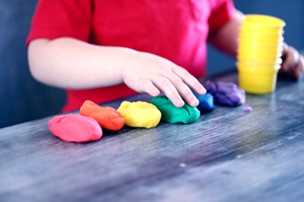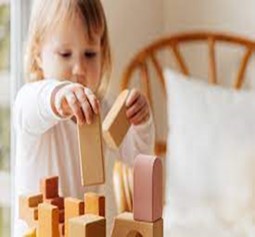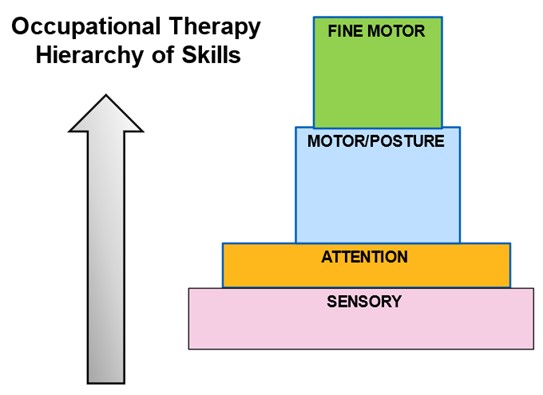Play and Autism
Why is play important?

Play is very important for children’s development. It is a child’s main task or job and goes hand in hand with learning.
Play helps develop a wide range of skills.
Skills children develop through play include:
- Big body skills
- Hand-eye coordination
- Visual perceptual skills
- Fine motor skills
- Cognitive skills
- Imagination and creativity
- Attention skills
- Social skills
- Emotional understanding and regulation
Play and Autism

Your autistic child’s play may look a bit different to that of their neurotypical peers. Some differences may include:
- Wanting to do the same play with the same toys or objects over and over as it is predictable to them and therefore calming and gives them a sense of control over their world.
- Repetitive play may include lining objects up, colour coordinating them, placing them in height from tallest to smallest or grouping them into category. This is still play as children explore and discover similarities and differences.

- Focusing on the detail of toys or objects, as they may spin the wheels of a car, or keep moving the propeller of a plane and maybe not playing with the toy as it was intended.
- Preferring to play alone or next to other children but not with them. They may find that playing with adults is easier than playing with children, as adults are more flexible and patient and allow them to control the game. Other children may change the game and ideas too quickly, which might make it unpredictable for your child and they may feel out of their comfort zone.

- Constantly be moving about and exploring their body and sensory needs like spinning or hanging upside down, or jumping off furniture, this is also play as they are experimenting and using their body to experience the sensations they need.
We have created this video which explains more about play, autism and how you can support your child’s play.
You can click here to read a written transcript of this video.
Before you start
Before you start thinking about joining your child in play, it can be helpful to think about whether there is anything we can do to set them up well for play. The occupational therapy hierarchy is about making sure we have the foundations before moving to the next level, even though all these skills are developing at once.

The pink area represents sensory environment. Think about the space. For example:
- What is the noise level in the room?
- Is the area clear of clutter?
- Does the space feel easy to relax and concentrate in?
The orange area represents your child’s attention skills. Think about whether your child can focus on a game with you. Do you feel they ready to play?
- Might it be a good to have a movement break before starting to play together?
- Look at the advice and video on our sensory needs page for more ideas on which sensory strategies will help get your child’s best attention.
If it’s often very difficult to get your child’s attention even for a very short time, take a look at our page on “Sharing Attention in Play” for ideas on how to build your child’s shared attention through play.
The blue area represents your child’s posture and large motor skills. Think about where they are most comfortable in terms of the play set-up. Is it better for them to be sitting on the floor or at a table? Where are they able to sit and relax or do they prefer to move around while playing?
The green area represents their fine motor skills. If your child struggles with picking up small items when playing, you can support them to practice this by picking up small items like beads, cheerios or raisins using a tripod grasp (thumb, index finger and middle finger). For more information on how to support your child in developing their fine motor skills, please click here.
Having thought about the above areas, now you are ready to play!
Top tips for joining your child in play
- Play alongside them and copy what they are doing
- Model one new way to play with a toy
- Introduce a quick turn taking game like rolling a ball to them, placing a brick to help build a tower, or passing them an item they need
- Use timers or visual like a “now and next” board, you can help your child to feel relaxed by showing them that now they are playing together, next they can go back to their own game.
- Games with clear rules are easier to join, such as catching games or easy board games like snakes and ladders, or lotto.
Start where your child is at and set a goal
Think about what your child can do and build on that in small steps. For example, if you want to help them work towards doing a jigsaw, you can progress from using a shape sorter, to a simple inset puzzle, to a two-piece puzzle and finally a jigsaw. Start where you child is at.

Similarly, construction toys, you can start with Duplo before continuing to Lego, and finally more complex construction toys such as Popoids.

You can apply the same approach to many activities and goals. Just break down the task into simpler steps and work through them slowly.
What’s Next?
- Come to a Next Steps Session. If your child is currently being supported by Islington Social Communication Team you can sign up for an Occupational Therapy Next steps session to discuss your questions and queries with members of our team, along with other families facing similar challenges. You can find dates and details of how to book here.
Last updated10 Sep 2025

